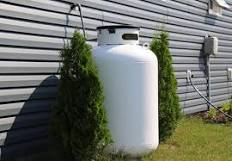It’s finally Spring. Time to clean up the Winter mess, bring your yard to life, and maybe add some fresh new ideas to your home and gardens. You may wonder if there is any project that can make your propane tank stand out less. There it is, in all its industrial glory, in your yard, for all to see. If you’ve ever been thinking about that, here are a few commonly asked questions and ideas for making it a little less obvious.

Is It Legal to Paint a Propane Tank?
Yes, it is legal to paint your propane tank. It’s important to remember that you can only paint propane tanks that you own. You are not allowed to paint a propane tank that you are leasing from a propane company. If you are unsure, please call your propane provider.
Is It Safe To Paint a Propane Tank?
Yes, it is safe to paint your propane tank. However, you can only use specific colors and paint. You’ll need to stick with light, reflective tones so the tank doesn’t increase temperature in the hot Summer sun. Use exterior paints that will weather well. Please check with your propane provider for any applicable precautions or rules applicable.
How Can I hide a propane tank?
- Plant a “privacy screen” around your propane tank.

When designing your landscape with an above-ground propane tank, this means breaking up a large, solid white object on a field (typically) of green.One reliable creative solution that we like is to build a natural screen with plants that have enough size and volume to “support” the tank, but that have lots of branches and foliage moving in several directions so as not to emphasize the bulk of the tank itself.
Use plants and shrubs that provide volume, texture, and height to beautify your landscape while tastefully keeping your tank from view. Have fun and experiment! - Place an actual fence in front of the propane tank.

Another popular and effective strategy is to block the propane tank with a fence or other barrier. Here, too, remember the safety guidelines about enclosures, and be mindful of the idea that less is more: Fencing your tank inside four walls will only draw more attention to it. Alternatively, a single wall — or two walls, either parallel to each other on either side of the tank or forming a corner around one end of the tank — can add an elegant, rustic, quaint aesthetic to the garden while preserving your home’s curb appeal.Again, safety is paramount here. Do not enclose the tank entirely. We also don’t recommend boxes or crates for hiding the tank. These methods restrict ventilation of propane fumes and pose a safety hazard.
Leave plenty of space around the tank — and around your plants. - Can I plant over underground tanks?

When landscaping over underground propane tanks, you have even more freedom. You can plant almost anything except trees next to or over a propane tank. The tanks are placed deep enough into the ground that most root systems aren’t likely to affect them.As with above-ground tanks you have to leave room for filling up and for the release valve. Access does not necessarily mean keeping the area bare, especially when it comes to landscaping over underground tanks. Hardy groundcovers such as pachysandra, mondo grass, creeping thyme, or phlox provide beautiful color and texture that will help cloak your tank cover — and they’re tough enough to step on occasionally.
Just as there are strict safety regulations around where your tank is placed, the rules for safety, use, and access when putting anything near the tank are equally important. Here are the rules you’ll need to be aware of:

- Do not plant or place anything less than five feet away from any part of an above-ground tank. This keeps objects away from the tank that might restrict ventilation and allows technicians to access the tank when needed.
- Do not fully enclose the tank. No matter how far you place the walls of the enclosure from the tank, it is never okay to enclose your propane tank. Don’t place it in a fully enclosed fence, box, crate, or other device designed to hide a propane tank. These methods restrict ventilation of propane fumes and pose a safety hazard.
- Do not block tank access. If you have an underground propane tank, the lid must be clearly visible and accessible. For above-ground tanks, make sure nothing restricts access to any visible tank valves or openings.
- Always leave clear access to the propane tank. Technicians need an open path to the tank, for both maintenance and repairs and when refilling.
If you have any questions, please call us and we can help guide you.